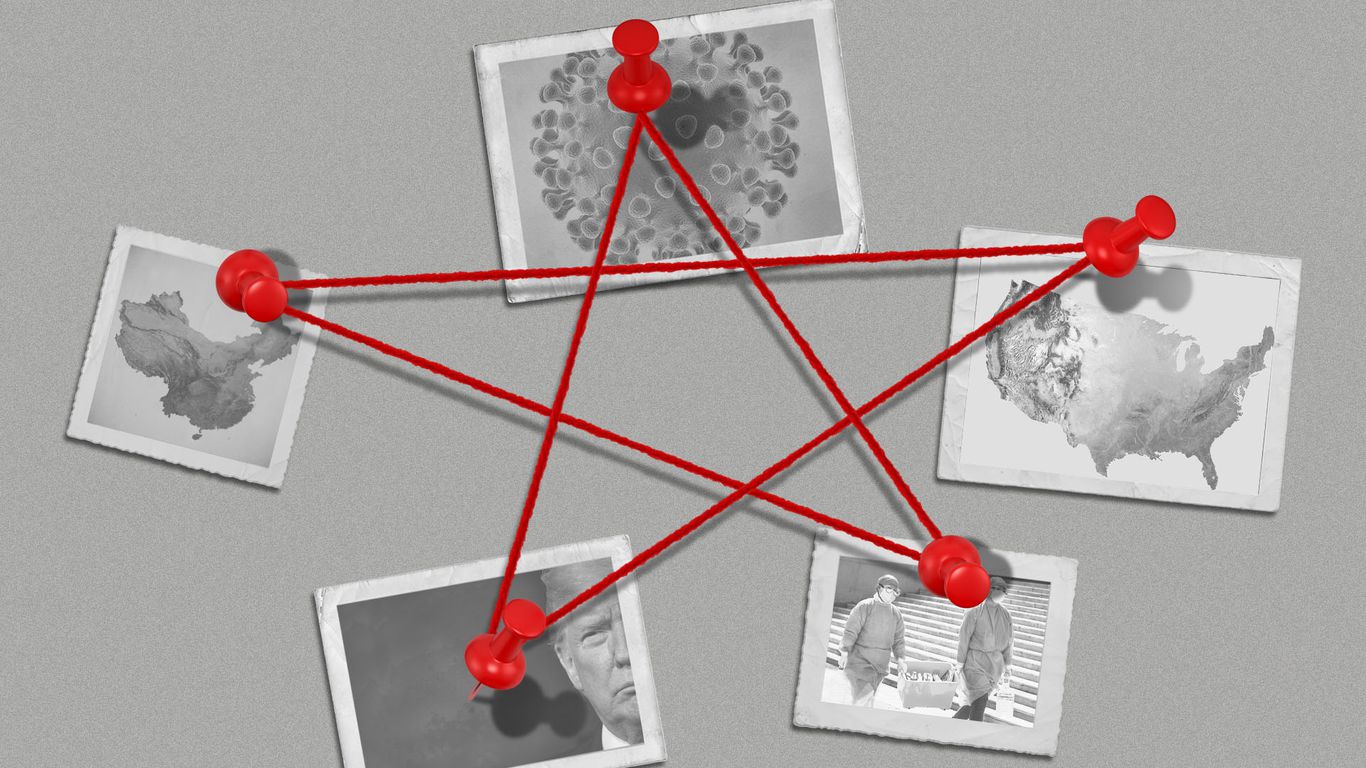China adopts Russia’s disinformation playbook

The Chinese Communist Party has spent the past week publicly pushing conspiracy theories intended to cast doubt on the origins of the coronavirus, and thus deflect criticism over China’s early mishandling of the epidemic.
Why it matters: The strategy is a clear departure from Beijing’s previous disinformation tactics and signals its increasingly aggressive approach to managing its image internationally.
What’s happening: Verified Chinese government Twitter accounts, Chinese embassies and consulates, and some Chinese media outlets have promoted several different conspiracy theories about the origins of the coronavirus.
- One theory, tweeted multiple times by Chinese foreign ministry deputy spokesperson Zhao Lijian and boosted by official Chinese state media, states that the virus may have come from a U.S. military lab.
- Another suggests the disease first appeared in Italy in November, before it appeared in Wuhan.
- Numerous pronouncements from a variety of Chinese government sources have stated more vaguely that the virus may not have come from Wuhan, the city in Hubei where the outbreak began.
Reality check: Virologists say the coronavirus shows no signs of being engineered in a lab, and epidemiologists agree that the first outbreak was in Wuhan.
- China’s ambassador to the U.S. Cui Tiankai has disavowed the conspiracy theory, calling it “crazy” in an interview with “Axios on HBO.”
The big picture: Beijing is emulating Russia’s disinformation playbook.
- “What we’ve seen over the past week and a half over COVD-19 in terms of Chinese party-state manipulation has been a real departure from what we have seen in the past,” Laura Rosenberger, director of the Alliance for Securing Democracy at the German Marshall Fund of the United States, tells Axios.
Rosenberger points to three main tactics that Beijing has applied in its coronavirus messaging campaign that clearly resemble Russian strategy:
- The propagation of “multiple conflicting theories.”
- The amplification of “conspiracy websites,” which Rosenberger said are third-party sites without funding transparency that promote the same theories the state aims to boost.
- The coordinated use of diplomatic and embassy Twitter accounts and state-backed media to help boost the theories.
Russian disinformation tactics typically aim to destabilize the information environment through spreading conspiracy theories, with the goal of creating chaos and discord in target societies. This strategy has been widely deployed in recent years to:
- Interfere in the 2016 U.S. presidential election.
- Disassociate Russia from its poisoning of former Russian military officer Sergei Skripal on British soil in 2018.
- Cast doubt on Russia’s role in the downing of Malaysian Airlines flight MH17 over Ukraine in July 2014.
But Chinese Communist Party disinformation has previously followed methodology and goals distinctly different from Russia’s.
- Chinese information operations typically aim to uphold a single immutable narrative that casts the Chinese Communist Party in a positive light.
- There is intense censorship inside China of information that makes the party look bad, as well as suppression of dissenting narratives outside China. The suppression is often done through coercion — increasingly, by threatening to deny market access to organizations if they say things the party doesn’t like.
- The goal isn’t to destabilize the information environment, but rather to make Beijing appear unassailably good.
- But unlike Russia, this strategy typically doesn’t target foreign societies beyond their perceptions of China.
It isn’t either/or. Beijing continues to employ the above strategy both at home and abroad as it strives to deflect blame for its early cover-up of the epidemic and to show itself a more reliable partner to countries than the United States.
- China has embarked on an international humanitarian relief campaign to provide medical supplies to dozens of countries fighting outbreaks of their own, accompanied by a major propaganda blitz.
- It’s an “aggressive information campaign to portray China as the new partner of first resort,” said Rosenberger, and ” U.S. missteps” have created “fertile ground” for this message to take hold.
Go deeper:

